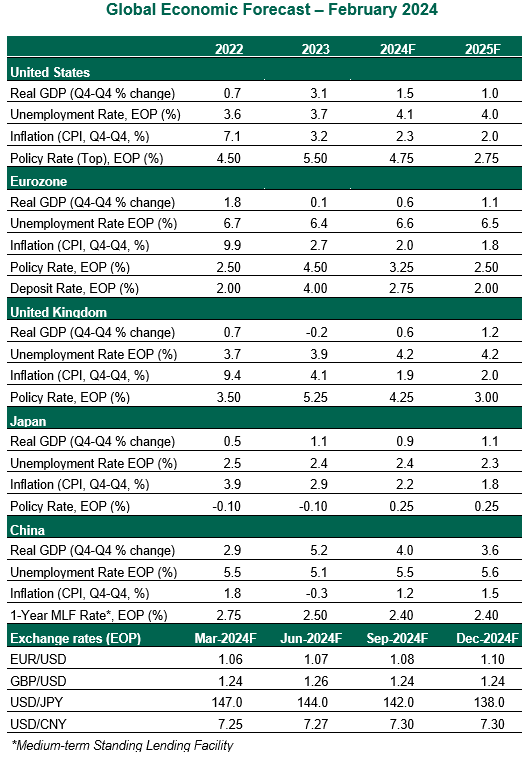by Carl Tannenbaum, Vaibhav Tandon, Ryan James Boyle, Northern Trust
The Northern Trust Economics team shares its outlook for major markets.
Soft landings are rare and hard to achieve. But we think the world’s major economies are close to pulling off this impressive feat. Incoming data has painted a picture of cooling inflation without a spike in joblessness. The odds of a severe recession have fallen.
Nonetheless, central bankers on either side of the Atlantic have pushed back against expectations that looser policy is just around the corner. Tight labor markets have been the main hurdle. Improvements in supply chains and commodity costs have likely run their courses, so further progress on inflation may become more difficult. Without it, interest rates will remain well above their neutral levels.
That said, geopolitical events could be game-changers. The Ukraine war, tensions in the Middle East, and China’s struggles (among other situations) could alter the outlook on short notice. Here are our up-to-date perspectives on how major economies are poised to perform during this year and next.
United States
- U.S. real gross domestic product (GDP) grew by a solid 3.1% year over year in the fourth quarter of 2023—overcoming a year of high interest rates, high inflation and high recession expectations. Consumer spending was one of the key drivers, backed by a hot labor market. Outsized gains are unlikely to continue in 2024, but growth should stay in line with potential.
- At its January meeting, the Federal Reserve brought no change to interest rates or asset reductions. However, the accompanying statement indicated that the committee will not cut rates “until it has gained greater confidence that inflation is moving sustainably toward 2 percent.” The cautious stance is explained by the still-tight labor market conditions and stubborn core inflation. We expect a total of four 25 basis point reductions, beginning in June.
Eurozone
- The eurozone economy weakened in the second half of 2023, dragged down by higher borrowing costs, subdued confidence and waning competitiveness. The near-term outlook is not good, but not bad, either. Incoming surveys and data suggest that the recovery is gaining traction from a low base. Demand is expected to recover gradually as real disposable income rises, supported by declining inflation, robust wage growth and resilient employment.
- Inflation in the euro area has continued to cool, led by falling goods prices. But the hard work lies in taming services inflation. It has decelerated, but is proving to be sticky. Soft demand should exert further downward pressure on the prices of services; this would give the European Central Bank confidence that inflation is heading sustainably toward its 2% target.
United Kingdom
- The U.K economy fell into a technical recession as private consumption contracted again alongside declines in trade and government spending. But encouragingly, business investment rose. An improvement is in store in 2024. Short-term indicators and surveys suggest the economy entered the year on a positive footing. Inflation is falling sharply and will drop below the 2% mark in the coming months, boosting real wages. With a large share of debt linked to inflation, moderating price pressures have led to a notable drop in debt interest payments. This will give the government headroom to ease its fiscal stance in an election year.
- Revised labor force data suggest that Britain’s job market is tighter than previously thought. The unemployment rate declined last year from 4.3% in July to 3.8% in December, well below the central bank’s initial estimate of 4.3%. The revisions could complicate the Bank of England’s (BoE) job in gauging the labor market. Fortunately, price and wage gains are moderating. At its most recent meeting, the BoE kept the policy rate unchanged at 5.25%. We expect a total of 100 basis points of cuts in 2024, starting in the second half of the year.
Japan
- The Japanese economy also slipped into recession as private consumption and capex declined for the third straight quarter. But growth is likely to return to positive territory as inflation moderates and real incomes improve. With the external backdrop becoming less favorable, overall growth will remain modest in 2024.
- The removal of the Bank of Japan’s negative interest rate policy (NIRP) is on the horizon. The spring wage talks (Shuntō) are underway. Several major firms have already revealed competitive pay increase plans for 2024 amid labor shortages and robust corporate earnings. A high wage settlement in spring negotiations will give the Bank of Japan confidence that its inflation target can be achieved. We expect the BoJ to exit NIRP this year.
China
- The stock market is not the economy. But in China’s case, it is fundamentally a reflection of the state of the economy. China met its headline real growth target, expanding 5.2% in 2023. Yet, investor sentiment has turned sharply negative. Consumption growth has slowed, and confidence remains weak. Deflation worries are deepening; the consumer price index declined 0.8% year over year, the steepest decline in 15 years. China could try to export its way out of trouble, but doing so will renew trade tensions with Washington in an election year.
- Weak sentiment has prompted additional stimulus. But the policy reaction remains incremental. With the People’s Bank of China reiterating its supportive stance, we continue to expect more easing measures to provide a floor under growth.

Copyright © Northern Trust















